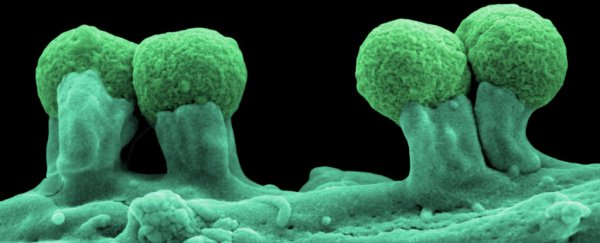Scientists have engineered the first ever 'semi-synthetic' organisms, by breeding E. coli bacteria with an expanded, six-letter genetic code.
While every living thing on Earth is formed according to a DNA code made up of four bases (represented by the letters G, T, C and A), these modified E. coli carry an entirely new type of DNA, with two additional DNA bases, X and Y, nestled in their genetic code.
The team, led by Floyd Romesberg from the Scripps Research Institute in California, engineered synthetic nucleotides - molecules that serve as the building blocks of DNA and RNA - to create an additional base pair, and they've successfully inserted this into the E. coli's genetic code.
Now we have the world's first semi-synthetic organism, with a genetic code made up of two natural base pairs and an additional 'alien' base pair, and Romesberg and his team suspect that this is just the beginning for this new form of life.
"With the virtually unrestricted ability to maintain increased information, the optimised semi-synthetic organism now provides a suitable platform [to] … create organisms with wholly unnatural attributes and traits not found elsewhere in nature," the researchers report.
"This semi-synthetic organism constitutes a stable form of semi-synthetic life, and lays the foundation for efforts to impart life with new forms and functions."
Back in 2014, the team announced that they had successfully engineered a synthetic DNA base pair - made from molecules referred to as X and Y - and it could be inserted into a living organism.
Since then, they've been working on getting their modified E. coli bacteria to not only take the synthetic base pair into their DNA code, but hold onto it for their entire lifespan.
Initially, the engineered bacteria were weak and sickly, and would die soon after they received their new base pair, because they couldn't hold onto it as they divided.
"Your genome isn't just stable for a day," says Romesberg. "Your genome has to be stable for the scale of your lifetime. If the semisynthetic organism is going to really be an organism, it has to be able to stably maintain that information."
Over the next couple of years, the team devised three methods to engineer a new version of the E. coli bacteria that would hold onto their new base pair indefinitely, allowing them to live normal, healthy lives.
The first step was to build a better version of a tool called a nucleotide transporter, which transports pieces of the synthetic base pair into the bacteria's DNA, and inserts it into the right place in the genetic code.
"The transporter was used in the 2014 study, but it made the semisynthetic organism very sick," explains one of the team, Yorke Zhang.
Once they'd altered the transporter to be less toxic, the bacteria no longer had an adverse reaction to it.
Next, they changed the molecule they'd originally used to make the Y base, and found that it could be more easily recognised by enzymes in the bacteria that synthesise DNA molecules during DNA replication.
Finally, the team used the revolutionary gene-editing tool, CRISPR-Cas9 to engineer E. coli that don't register the X and Y molecules as a foreign invader.
The researchers now report that the engineered E. coli are healthy, more autonomous, and able to store the increased information of the new synthetic base pair indefinitely.
"We've made this semisynthetic organism more life-like," said Romesberg.
If all of this is sounding slightly terrifying to you, there's been plenty of concern around the potential impact that this kind of technology could have.
Back in 2014, Jim Thomas of the ETC Group, a Canadian organisation that aims to address the socioeconomic and ecological issues surrounding new technologies, told the New York Times:
"The arrival of this unprecedented 'alien' life form could in time have far-reaching ethical, legal, and regulatory implications. While synthetic biologists invent new ways to monkey with the fundamentals of life, governments haven't even been able to cobble together the basics of oversight, assessment or regulation for this surging field."
And that was when the bacteria were barely even functioning.
But Romesberg says there's no need for concern just yet, because for one, the synthetic base pair is useless. It can't be read and processed into something of value by the bacteria - it's just a proof-of-concept that we can get a life form to take on 'alien' bases and keep them.
The next step would be to insert a base pair that is actually readable, and then the bacteria could really do something with it.
The other reason we don't need to be freaking out, says Romesberg, is that these molecules have not been designed to work at all in complex organisms, and seeing as they're like nothing found in nature, there's little chance that this could get wildly out of hand.
"[E]volution works by starting with something close, and then changing what it can do in small steps," Romesberg told Ian Sample at The Guardian.
"Our X and Y are unlike natural DNA, so nature has nothing close to start with. We have shown many times that when you do not provide X and Y, the cells die, every time."
Time will tell if he's right, but there's no question that the team is going to continue improving on the technique in the hopes of engineering bacteria that can produce new kinds of proteins that can be used in the medicines and materials of the future.
As Romesberg asserts, "This will blow open what we can do with proteins."
The research has been published in Proceedings of the National Academy of Sciences.
